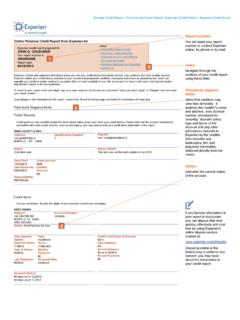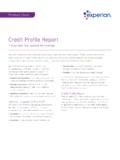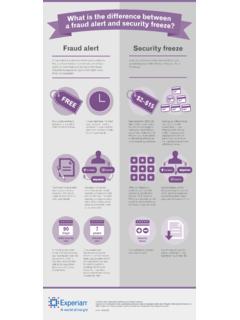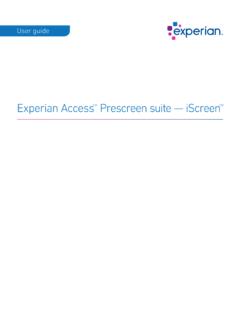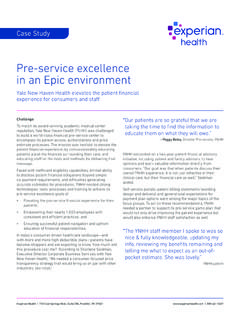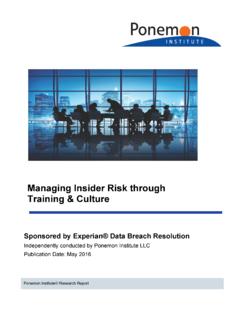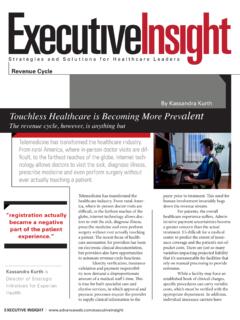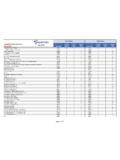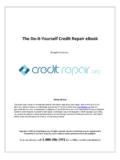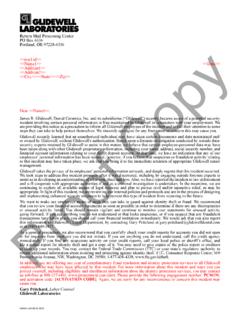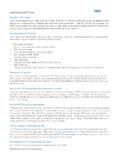Transcription of Data reporting guidebook - Check Your Credit …
1 data reporting guidebookEnergy and communications industriesData reporting | i data reporting guidebookEnergy and communications industries 2008 experian Information Solutions, Inc. All rights reserved. Title and copyright in this document at all times belong to experian and may only be used by employees of the client authorized for such purpose. This document (or any part of it) shall not be copied or reproduced (in any form whatsoever), transmitted or stored within a retrieval system or disclosed to any third party without the prior written consent of experian . experian reserves the right to revise or otherwise alter this publication and associated software and to make changes to the content thereof, without obligation to notify any person of such changes or revisions. data reporting | iii Int roduction.
2 1 Chapter 1: data reporting ..2 What is data reporting ? ..2 experian s role in data reporting ..2 data security and permissible uses ..3 reporting types ..3 Case study 1 ..4 Benefits to consumers ..5 Onboarding process ..6 Case study 2 ..7 Chapter 2: Legal and compliance considerations ..8 Federal laws ..8 State and local laws ..9 Other Credit -granting legislation ..10 Chapter 3: Project management implementation overview ..11 Project timeline ..11 Building the business case ..12 Assigning a project team ..12 Developing contracts ..13 Achieving Metro 2 compliance ..13 Stakeholder communication ..14 Creating internal processes/procedures ..14 Steps for success ..15 Chapter 4: Building your business case ..16 experian s prereporting analysis ..16 The business case ..17 Summary ..18 Table of contentsiv | data reporting Chapter 5: Developing contracts.
3 19 experian data reporting contracts ..19 Current experian clients ..19 New clients ..19 data Release Agreement (DRA) ..19 Service Agreement (SA) ..19 Subscriber Questionnaire Document (SQD) ..20e-OSCAR registration process ..20 Required conversion documents ..20 Business Requirements Document (BRD) ..20 Chapter 6: Achieving Metro 2 compliance ..21 Requirements definition ..21 Metro 2 record layout ..21 Scenario development ..22 Account scenarios defined ..22 Programming ..23 Programming best status ..24 Sold accounts ..24 Payment arrangements ..24 Payment histories ..24 Special comment codes ..24 Compliance condition code ..25 Existing disputes and identity theft investigations ..25 Secondary names ..25 Exclusions to initial reporting ..25 data cleanup ..25 Defect testing ..26 File transfer, test and analysis.
4 26 Live reporting ..26 Transition period/Code modifications ..26 Table of contentsData reporting | v Chapter 7: Stakeholder communication ..27 Communication plan development ..27 Stakeholder assessment ..27 Communication plan components ..29 Illustrative communication timeline ..30 Stakeholder education ..31 Consumer communicat ion ..33 Chapter 8: Creating internal processes and e-OSCAR dispute management process ..35 Creating a dispute resolution strategy ..36 Training ..38 Measuring and monitoring performance ..39 Frequently asked questions (FAQ) ..41 data reporting ..41 data types and transmission ..41 Implementation ..42 Legal ..42 Communicat ion ..43 Dispute resolution ..43 Glossary ..45 Table of contentsData reporting | 1 Introduct ionIntroduct ionThe energy and communications industries reporting guidebook was created by experian analysts and industry experts.
5 This guidebook includes an overview of data reporting , detailed information on the potential benefits to your business and customers, steps for success, how to implement reporting for your utility, several case studies and an integrated set of industry best practices. Frequently asked questions and a glossary of terms also are included at the end of the document. This guidebook should help further your understanding of the use of data reporting in the energy and communications industries. Of course, the experience of individual utilities varies, and experian cannot guarantee any particular result for your reporting involves a number of different legal and regulatory standards. While this guidebook offers experian s perspective on some of the laws and regulations generally applicable to data reporting , it does not constitute legal advice.
6 You should consult with your own legal counsel regarding your company s situation before taking any action with respect to any matter discussed in this you are interested in reporting to experian or have questions regarding the content in this document, please contact experian s Membership Services at 1 800 831 | data reportingChapter 1: data reportingData reportingGood Credit is a valuable asset in today s economy, and data reporting is a highly effective tool for managing collections and building Credit . For many years, data reporting has been a successful tool companies use to promote timely bill payments from consumers. Over time, consumers have adopted the idea that payment behavior with lenders that do report potentially impacts their overall Credit score. Additionally, it also may affect their ability to attain needed Credit or competitive rates.
7 As with banks and other lending institutions that have traditionally reported, utilities should begin to see the same positive effects timely bill payments and improved collections. Utility companies that do report have shared their experiences with experian regarding the benefits of reporting , as well as their interaction with external stakeholders such as lenders, the media and consumer groups. One common misconception brought up by these groups is that data reporting may hurt consumers. Studies show that this is not the case data reporting can actually help consumers. Consumers who do not pay their bills and are sent to collections typically already are reported to a consumer reporting agency through collections or through a company s internal collections department. This means the consumers with delinquent behavior already are being affected by data reporting .
8 The consumers who benefit are those who pay their bills on a timely basis or have the ability to pay on time. data reporting will reflect these timely payments and help build both their Credit profile and score. Ultimately, it can encourage prompt payment habits from consumers and reward them for their positive payment s interaction with clients and review of research suggest that full file data reporting can help improve a company s bottom line. reporting data to experian is a safe and effective way of sharing Credit information, and there is no cost to report. What is data reporting ? data reporting is the reporting of consumer Credit information by a business where a payment is required for a product or service that has been received or used by a consumer. Businesses that report data , called data reporters or data furnishers, are responsible for the secure electronic transfer of consumer payment information to a Credit reporting agency (CRA), such as experian .
9 Once the information is received, the CRA includes it in its database and a tradeline is created on each consumer. A tradeline is a single line on the Credit report stating information about the consumer s financial account. Consumers may have few or multiple tradelines on their record. Together, all tradelines reported on a specific consumer make up his or her Credit report and can be used to determine the consumer s overall risk or creditworthiness. experian s role in data reportingExperian is a global leader in providing information, analytical and marketing services to organizations and consumers to help manage the risk and reward of commercial and financial decisions. Combining its unique information tools and deep understanding of individuals, markets and economies, experian partners with organizations around the world to establish and strengthen customer relationships and provide their businesses with competitive advantage.
10 Clients include organizations from financial services, retail and catalog, telecommunications, utilities, media, insurance, automotive, leisure, e-commerce, manufacturing, property and government reporting | 3 Chapter 1: data reportingData security and permissible usesData reporting involves the transfer of and access to consumer Credit information. Therefore, the Credit industry is highly regulated. CRAs, like experian , are responsible for storing the data and carefully following procedures for the handling and use of the information. Dynamic information privacy standards and security and fraud prevention policies are in place at also are limited permissible uses of consumer Credit information. Some of the most common reasons for access include the following: Determining a consumer s Credit risk for loans, lines of Credit or Credit cards Ascertaining the need for a deposit (utilities, telecommunications and rental properties) Providing information or verification for employment purposes, insurance underwriting or rental decisioningTo learn about other Fair Credit reporting Act (FCRA) permissible uses, please visit typesThere are two traditional methods of data reporting : derogatory and reportingDerogatory-only reporting involves the sole reporting of negative consumer payment information to a CRA.
